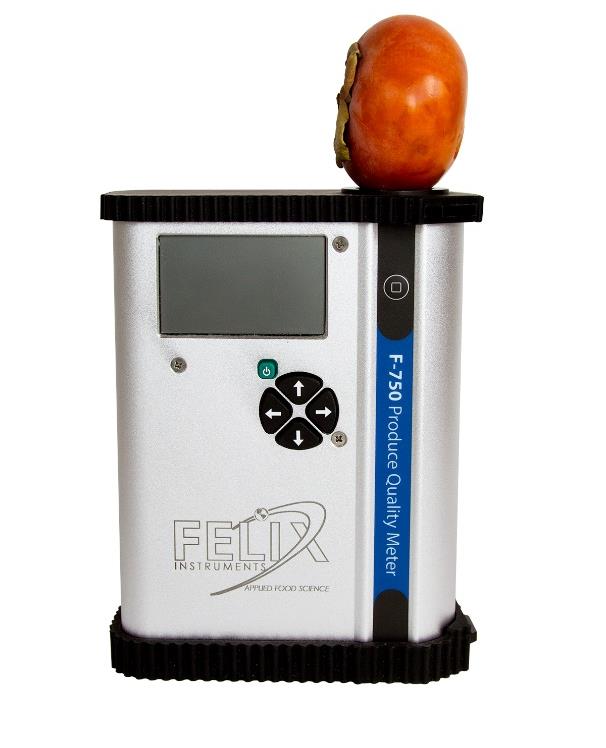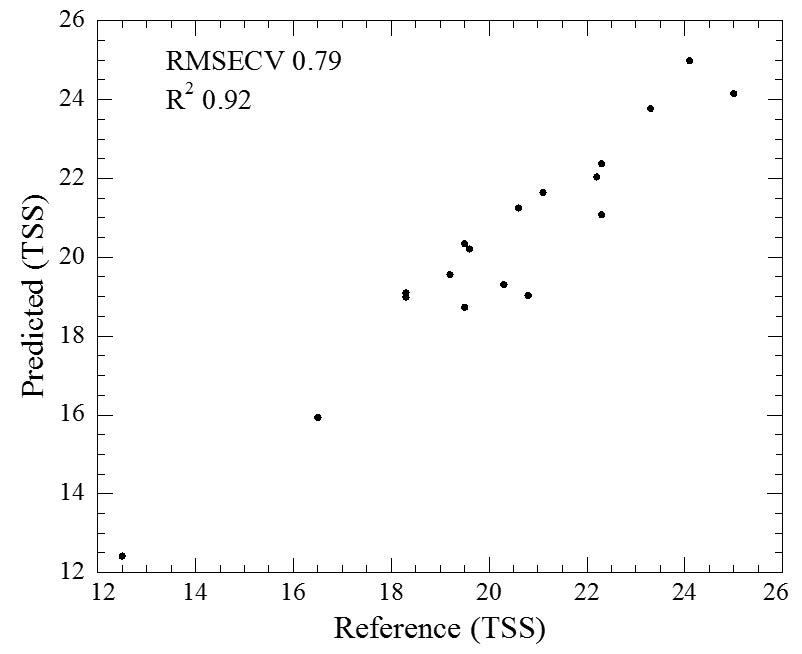April 21, 2016 at 11:04 pm | Updated April 21, 2016 at 11:04 pm | 3 min read
Non-destructive Measurements of Total Soluble Solids in Chocolate Persimmon (Diospyros kaki)
Sugar (Total Soluble Solids (TSS) or ºBrix) content is regularly measured in persimmons throughout development and storage. Using traditional methodology, TSS measurements are destructive and time consuming. To determine effectiveness and viability of the F-750 Produce Quality Meter for non-destructive measurements of TSS in persimmon, a modeling study was conducted on 20 chocolate persimmons. Destructive reference values were correlated with the non-destructive spectral data collected with the F-750 using the F-750 Model Builder Software, and results show that the F-750 Produce Quality Meter precisely and non-destructively measures TSS in persimmon, with a calculated root mean square error of cross validation of 0.79 TSS.
Materials and Methods:
Subscribe to the Felix instruments Weekly article series.
By submitting this form, you are consenting to receive marketing emails from: . You can revoke your consent to receive emails at any time by using the SafeUnsubscribe® link, found at the bottom of every email. Emails are serviced by Constant Contact
In September 2015, 20 chocolate persimmons were used to create a new model for the F-750 Produce Quality Meter. Using the screws on the lens housing as alignment markers, persimmons were consistently presented and scanned on the F-750 Produce Quality Meter at room temperature (20OC). Next, the same persimmon regions scanned with the F-750 were destructively measured for Total Soluble Solids (TSS) using the method described in Felix Instruments Mango Standard Operating Procedure (SOP). The spectral range of 729-969 nm was used by the F-750 Model Builder Software to detect correlations between the F-750 spectral signal and corresponding TSS values. The resulting regression data was analyzed for linearity, root mean square error, and leave-one-out cross validation error to determine the applicability and accuracy of the created model.

Figure 1. Fruit presentation for measuring persimmon with the F-750.
Results and Discussion:
Results show that the F-750 Produce Quality Meter precisely, simultaneously, and non-destructively measures the TSS of persimmon. A strong correlation between spectral data and collected reference values is illustrated by a model prediction R2 of 0.92 for TSS. Figure 2 displays this correlation and demonstrates the consistency of measurement.
A calculated Root Mean Square Error of Cross Validation (RMSECV) of 0.79 TSS further illustrates the accuracy of the created model. This RMSECV value is an estimation or simulation of error for a given measurement when the model is loaded onto the F-750 and used to predict TSS. The RMSECV is equivalent to the expected uncertainty within 68% of all predictions.

Figure 2. F-750 prediction value against reference method value of Total Soluble Solids in persimmon.
Conclusions:
The F-750 Produce Quality Meter accurately predicted Total Soluble Solids (TSS) in persimmon. Other tests and research findings have demonstrated the ability to measure other important internal fruit metrics with NIR technology. Similar results are expected for the F-750 Produce Quality Meter with other persimmon varieties and traits.
Further Reading and Supporting Science:
Jannok, P., Kamitanib, Y., & Kawanob, S. (2014). Development of a common calibration model for determining the Brix value of intact apple, pear and persimmon fruits by near infrared spectroscopy. Journal of Near Infrared Spectroscopy, 22(5): 367-373.
Liu, R., Qi, S., & Han, D. (2015). Measurement of soluble solids content of three fruit species using universal near infrared spectroscopy models. Journal of Near Infrared Spectroscopy, 23(5): 301-309.
Zanamwe, Pesanai. (2014). The role of harvest time and maturity, orchard and simulated wind on postharvest quality of ‘Triumph’ persimmon fruit and the potential of NIR as non-destructive sorting tool. Thesis (MScAgric), Stellenbosch University.
Related Products
- F-751 Grape Quality Meter
- Custom Model Building
- F-901 AccuStore
- F-751 Melon Quality Meter
- F-751 Kiwifruit Quality Meter
- F-750 Produce Quality Meter
- F-751 Avocado Quality Meter
- F-751 Mango Quality Meter
- F-900 Portable Ethylene Analyzer
- F-950 Three Gas Analyzer
- F-920 Check It! Gas Analyzer
- F-960 Ripen It! Gas Analyzer
- F-940 Store It! Gas Analyzer
Most Popular Articles
- Spectrophotometry in 2023
- The Importance of Food Quality Testing
- NIR Applications in Agriculture – Everything…
- The 5 Most Important Parameters in Produce Quality Control
- Melon Fruit: Quality, Production & Physiology
- Guide to Fresh Fruit Quality Control
- Fruit Respiration Impact on Fruit Quality
- Liquid Spectrophotometry & Food Industry Applications
- Ethylene (C2H4) – Ripening, Crops & Agriculture
- Active Packaging: What it is and why it’s important


